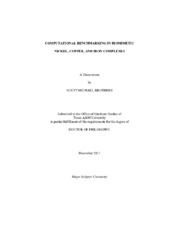| dc.description.abstract | Sophisticated catalytically active sites of metalloenzymes provide inspiration to synthetic chemists, as the metal coordination environments are often atypical to those found on the chemist's benchtop. Furthermore, metal-ligand cooperativity using earthabundant metals is anticipated to eventually supplant noble metals, currently used in industrial catalysis. Despite progress in synthesis of small molecule active site models, reproduction of the enzymatic function is rarely observed. However, differences that might define catalytic efficiency of enzymes can be addressed by theory. Density functional theory, or DFT, has been developed as an in silico tool to complement and interpret crystallographic and spectroscopic results or to make predictions in the absence of experimental data. In this dissertation, such techniques serve to elucidate the observed reactivity or electronic character of both nickel and copper bound in square planar N₂S₂ ligand fields, and of {Fe(NO)₂} units, respectively. Nickel and copper complexes in tetraanionic N₂S₂⁴⁻ ligand environments were investigated with respect to change of metal, to modification of ligand environment, and to response in reactivity of thiolate sulfur atoms. From the DFT calculations and consistent with experimental observations, it was discovered that binding of a nucleophile at one thiolate sulfur effectively decreases reactivity of the second sulfur, and nucleophilic binding at both sulfurs serves to deactivate the complex toward further thiolate reactivity. Additionally, despite both Cu and Ni binding comfortably in the N₂S₂⁴⁻ coordination sphere, the former displays increased ionicity versus the latter, demonstrated by electrostatic potential mapping. A methodology for accurate modeling of geometry and vibrational frequencies of complexes containing a {Fe(NO)₂} unit was determined from the results of a test set of complexes using a matrix of functionals and basis sets. Utilizing the optimum performer, the BP86 functional and a mixed SDD ECP basis set on iron and 6-311++G(d,p) on other atoms, a series of iron dinitrosyl complexes containing diverse ancillary ligands spanning the spectrochemical series was subsequently investigated. The electrochemical potentials of the pairs of "oxidized" and "reduced" DNIC complexes were evaluated for values occurring in the biological regime. Furthermore, as the {Fe(NO)₂} unit is capable of coordination in interesting yet dissimilar geometric motifs, bimetallic, tetrameric, and adamantane-like DNIC complexes have been investigated with our DFT methodology. | en |


